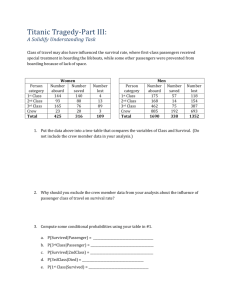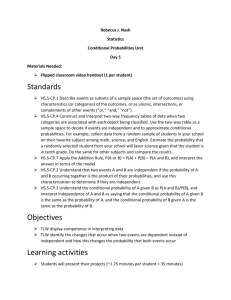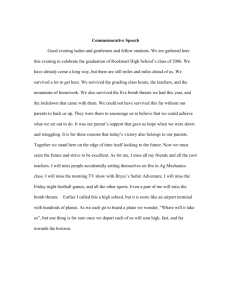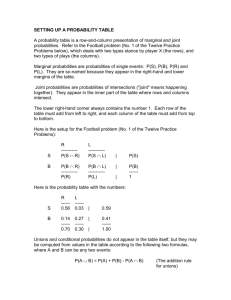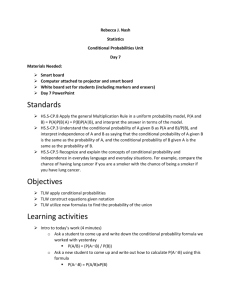H-103 Algebra 2 Statistics Standards
advertisement
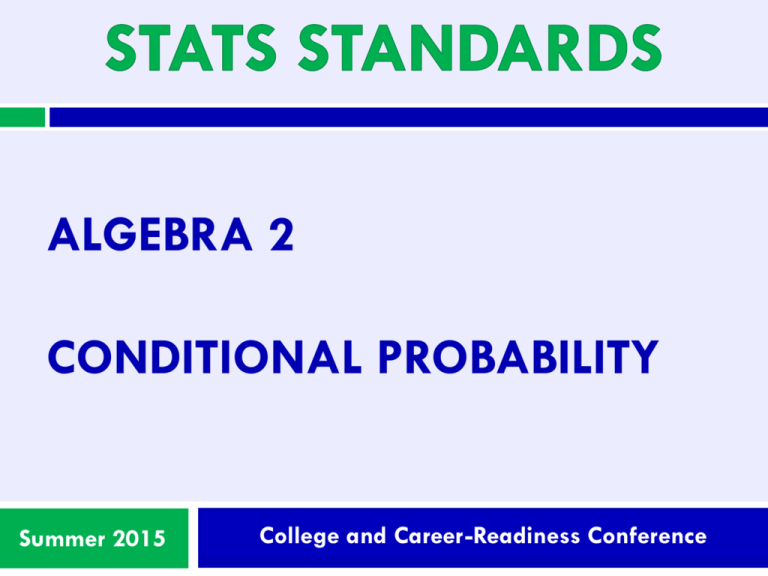
ALGEBRA 2 CONDITIONAL PROBABILITY Summer 2015 College and Career-Readiness Conference TODAY’S OUTCOMES Participants will: 1. Review Coherence as related to Conditional Probability Standards. 2. Take an in-depth look at the S-CP standards taught in Algebra 2. 3. Share best practices and identify muddy points. Introductions Cluster A. Understand independence and conditional probability and use them to interpret data Cluster B. Use the rules of probability to compute probabilities of compound events. OUTCOME 1 Participants will: 1. Review Coherence as related to Conditional Probability Standards. A purposeful placement of standards to create logical sequences of content topics that bridge across the grades and courses, as well as across standards within each grade/course. In what grade/subject do students: Use the two-way table as a sample space to decide if events are independent and to approximate conditional probabilities. - Algebra 2 Find probabilities of compound events using organized lists, tables, tree diagrams, and simulation. - Grade 7 Construct and interpret a two-way table summarizing data on two categorical variables. - Grade 8 From HSA to PARCC Students will calculate theoretical probability or use simulations or statistical inference from data to estimate the probability of an event. HSA or PARCC? HSA - Statistics 3.1.3 The student will calculate theoretical probability or use simulations or statistical inference from data to estimate the probability of an event. 3.2.1 The student will make informed decisions and predictions based upon the results of simulations and data from research. PARCC Model Content Framework Algebra 2 PARCC Evidence Statements Algebra 2 - EOY S-CP.Int.1 Solve multi-step contextual word problems with degree of difficulty appropriate to the course requiring application of course-level knowledge and skills articulated in S-CP i.) Calculating expected values of a random variable is a plus standard not assessed, however, the word “expected” may be used informally (e.g. if you tossed a fair coin 20 times, how many heads would you expect?). Cluster A. Understand independence and conditional probability and use them to interpret data Standard 1. …unions, intersections, or complements. Standard 2. …independent if the probability of A and B occurring together is the product of their probabilities… Standard 3. Understand the conditional probability of A given B as P(A and B)/P(B)… Standard 4. Construct and interpret two-way frequency tables… Standard 5. Recognize and explain the concepts of conditional probability and independence.. Cluster B. Use the rules of probability to compute probabilities of compound events. Standard 6. Find the conditional probability of A given B as the fraction of B's outcomes that also belong to A, and interpret the answer in terms of the model. Standard 7. Apply the Addition Rule, P(A or B) = P(A) + P(B) - P(A and B), and interpret the answer in terms of the model. Unions, Intersections, & Complementary Events – Venn Diagrams A B A∩B A∩B’ A’∩B’ B∩A’ Addition Rule of Probability S.CP.7 Formal P(AAddition or B) =Rule: P(A) + P(B) - P(A and B) P(A or B) = P(A) + P(B) - P(A and B) OR A B A∩B A’∩B’ P(A ∪ B) = P(A) + P(B) - P(A ∩ B) Example In a certain town, 40% of the people have brown hair, 25 % have brown eyes, and 15% have both brown hair and brown eyes. A person is selected at random from the town. Use this given information to answer the following questions. A. B. C. If a person is randomly selected, what is the probability that s/he has brown hair and not brown eyes? If a person is randomly selected, what is the probability that s/he has brown eyes and not brown hair? What is the probability that the person has neither brown hair nor brown eyes? Create a “Picture” to Model the Problem In a certain town, 40% of the people have brown hair, 25 % have brown eyes, and 15% have both brown hair and brown eyes. Create a “Picture” to Model the Problem In a certain town, 40% of the people have brown hair, 25 % have brown eyes, and 15% have both brown hair and brown eyes. Let H = people with Brown Hair Let E = people with Brown Eyes H E H∩E H∩E’ H’∩E’ E∩H’ Create a “Picture” to Model the Problem In a certain town, 40% of the people have brown hair, 25 % have brown eyes, and 15% have both brown hair and brown eyes. Let H = people with Brown Hair Let E = people with Brown Eyes P(H)=0.40 P(H∩E’) 0.25 P(H’∩ E’) 0.50 P(H∩ E) 0.15 P(E∩H’) 0.10 Solutions A. If a person is randomly selected, what is the probability that s/he has brown hair and not brown eyes? P(H∩E’) = 0.25 B. If a person is randomly selected, what is the probability that s/he has brown eyes and not brown hair? P(E∩H’) = 0.10 C. What is the probability that the person has neither brown hair nor brown eyes? P(H’∩E’) = 0.50 Solution – Two Way Table Brown Hair Yes Brown Eyes Yes 0.15 No 0.10 No 0.25 0.40 0.50 0.60 Total Total 0.25 0.75 1.0 A. If a person is randomly selected, what is the probability that s/he has brown hair and not brown eyes? P(H∩E’) = 0.25 B. If a person is randomly selected, what is the probability that s/he has brown eyes and not brown hair? P(E∩H’) = 0.10 C. What is the probability that the person has neither brown hair nor brown eyes? P(H’∩E’) = 0.50 Essential Skills and Knowledge S-CP.A.1 Describe events as subsets of a sample space (the set of outcomes) using characteristics (or categories) of the outcomes, or as unions, intersections, or complements of other events (“or,” “and,” “not”). Ability to describe a sample space. Understanding of and ability to use set notation, key vocabulary and graphic organizers linked to these standards. Essential Skills and Knowledge S-CP.A.4 Construct and interpret two-way frequency tables of data when two categories are associated with each object being classified. Use the two-way table as a sample space to decide if events are independent and to approximate conditional probabilities. Ability to connect experience with two-way frequency tables from Algebra 1 to sample spaces. Knowledge of characteristics of conditional probability Essential Skills and Knowledge S-CP.B.6 – Find the conditional probability of A given B as the fraction of B’s outcomes that also belong to A, and interpret the answer in terms of the model. Ability to analyze a situation to determine the conditional probability of a described event given that another event occurs. The Titanic - Task First class passengers Second class passengers Third class passengers Total passengers Survived Did not survive Total 201 123 324 118 166 284 181 528 709 500 817 1317 Share two thoughts or questions you have about the two – way table. Making Connections – Two way tables Calculate the following probabilities. Round your answers to three decimal places. 1) 2) 3) If one of the passengers is randomly selected, what is the probability that this passenger was in first class? If one of the passengers is randomly selected, what is the probability that this passenger survived? If one of the passengers is randomly selected, what is the probability that this passenger was in first class and survived? Solutions Making Connections – Two way tables Calculate the following probabilities. Round your answers to three decimal places. 4) If one of the passengers is randomly selected from the first class passengers, what is the probability that this passenger survived? (That is, what is the probability that the passenger survived, given that this passenger was in first class?) 5) If one of the passengers who survived is randomly selected, what is the probability that this passenger was in first class? 6) If one of the passengers who survived is randomly selected, what is the probability that this passenger was in third class? Conditional Probability Definition: The probability of an event occurring given that another event has already occurred is called a conditional probability. The probability that event B occurs, given that event A has already occurred is 𝑃 𝐵𝐴 = 𝑃(𝐴∩𝐵) 𝑃(𝐴) Solutions… 4) If one of the passengers is randomly selected from the first class passengers, what is the probability that this passenger survived? (That is, what is the probability that the passenger survived, given that this passenger was in first class?) P(survived|1st class) = 𝑃(1𝑠𝑡 𝑐𝑙𝑎𝑠𝑠∩𝑠𝑢𝑟𝑣𝑖𝑣𝑒𝑑) 𝑃(1𝑠𝑡 𝑐𝑙𝑎𝑠𝑠) P(survived|1st class) ≈ 0.620 = 201 324 Solutions… 5) If one of the passengers who survived is randomly selected, what is the probability that this passenger was in first class? (That is, what is the probability that the passenger was in first class, given that this passenger survived?) P(1st class|survived) = 𝑃(𝑠𝑢𝑟𝑣𝑖𝑣𝑒𝑑∩1𝑠𝑡 𝑐𝑙𝑎𝑠𝑠) 𝑃(𝑠𝑢𝑟𝑣𝑖𝑣𝑒𝑑) P(1st class|survived) ≈ 0.402 = 201 500 Solutions… 6) If one of the passengers who survived is randomly selected, what is the probability that this passenger was in third class? P(3rd class | survived) = 𝑃(𝑠𝑢𝑟𝑣𝑖𝑣𝑒𝑑∩3𝑟𝑑 𝑐𝑙𝑎𝑠𝑠) 𝑃(𝑠𝑢𝑟𝑣𝑖𝑣𝑒𝑑) P(3rd class | survived ) ≈ 0.362 = 181 500 PARCC Task – EOY #28 Part A Independence Definition – Two events are independent if the occurrence of one event does not effect the probability of the occurrence of the other event. The following four statements are equivalent A and B are independent events P(A and B) = P(A) * P(B) P(A|B) = P(A) “Probability of A given B” P(B|A) = P(B) “Probability of B given A” Independence P(A|B) = P(A) P(B|A) = P(B) Example: Using the Titanic example, are the events of surviving the tragedy independent of being in first class? (P(survived|1st class) = P(survived)?) P(survived|1st P(survived) = class) = 500 1317 𝑃(1𝑠𝑡 𝑐𝑙𝑎𝑠𝑠∩𝑠𝑢𝑟𝑣𝑖𝑣𝑒𝑑) 𝑃(1𝑠𝑡 𝑐𝑙𝑎𝑠𝑠) = 201 324 ≈ 0.620 ≈ 0.380 Since P(survived|1st class) ≠ P(survived), the events are not independent. Sorting Activity Sort the cards into two categories. dependent or independent events. Be ready to discuss. Solutions Dependent Independent Selecting a king from a standard deck, not replacing it, and then selecting a queen from the same deck. Tossing a coin and getting a head, and then rolling a six-sided die and obtaining a 6. Driving 85 miles per hour, and then getting in a car accident. Exercising frequently and having a 4.0 grade point average Smoking a pack of cigarettes per day, and developing emphysema, a chronic lung disease. Tossing a coin four times and getting four heads, and then tossing it a fifth time and getting heads. Returning a rented movie after the due date, and receiving a late fee. A red candy is selected from a package with 30 colored candies and eaten. A blue … Researchers found that people with depression are five times more likely… The events of getting two aces when two cards are drawn from a deck of playing cards and the first card is replaced before the second card is drawn. PARCC Task cont…. #28 Part B P(X|Y) ≠ P(X) P(female|right handed) ≠ P(female) 12 14 ≠ 23 30 Common Core State Standards for Mathematical Practice 1. Make sense of problems and persevere in solving them. 2. Reason abstractly and quantitatively. 4. Model with mathematics. 5. Use appropriate tools strategically. Best Practices What have you done that works? Additional Resources Illustrative Mathematics PARCC Practice Test Engage NY Module Mathematics Vision Project American Statistical Association What are the muddiest points? Record any question you still have after today’s presentation on your post-it note. Please provide your name and email address. Stick your post-it on the door as you leave today, and we will respond. Thank you! Teaching the Common Core content using the Standards for Mathematical Practice to reach progressively higher levels of proficiency attains mathematical rigor. -Hull, Balka, and Harbin Miles
